《英美报刊文章阅读》第三版课件---第三课
- 格式:ppt
- 大小:58.50 KB
- 文档页数:13



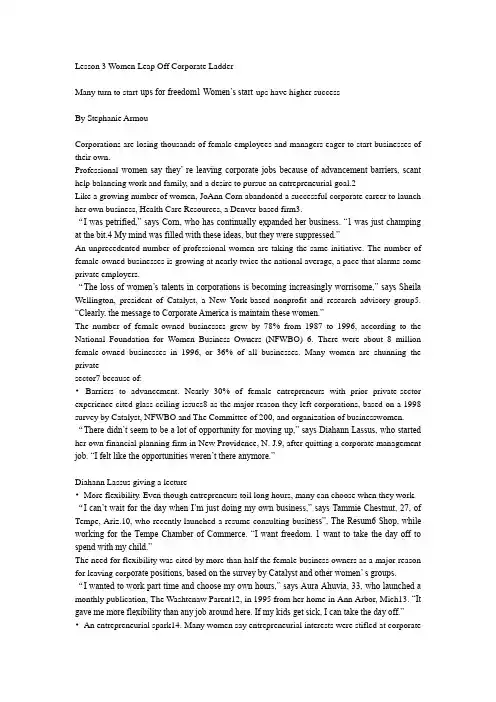
Lesson 3 Women Leap Off Corporate LadderMany turn to start-ups for freedom1 Women’s start-ups have higher successBy Stephanie ArmouCorporations are losing thousands of female employees and managers eager to start businesses of their own.Professional women say they’ re leaving corporate jobs because of advancement barriers, scant help balancing work and family, and a desire to pursue an entrepreneurial goal.2Like a growing number of women, JoAnn Corn abandoned a successful corporate career to launch her own business, Health Care Resources, a Denver-based firm3.“I was petrified,” says Corn, who has continually expanded her business. “1 was just champing at the bit.4 My mind was filled with these ideas, but they were suppressed.”An unprecedented number of professional women are taking the same initiative. The number of female-owned businesses is growing at nearly twice the national average, a pace that alarms some private employers.“The loss of women’s talents in corporations is becoming increasingly worrisome,” says Sheila Wellington, president of Catalyst, a New York-based nonprofit and research advisory group5. “Clearly, the message to Corporate America is maintain these women.”The number of female-owned businesses grew by 78% from 1987 to 1996, according to the National Foundation for Women Business Owners (NFWBO) 6. There were about 8 million female-owned businesses in 1996, or 36% of all businesses. Many women are shunning the privatesector7 because of:•Barriers to advancement. Nearly 30% of female entrepreneurs with prior private-sector experience cited glass-ceiling issues8 as the major reason they left corporations, based on a 1998 survey by Catalyst, NFWBO and The Committee of 200, and organization of businesswomen. “There didn’t seem to be a lot of opportunity for moving up,” says Diahann Lassus, who started her own financial planning firm in New Providence, N. J.9, after quitting a corporate management job. “I felt like the opportunities weren’t there anymore.”Diahann Lassus giving a lecture•More flexibility. Even though entrepreneurs toil long hours, many can choose when they work. “I can’t wait for the day when I’m just doing my own business,” says Tammie Chestnut, 27, of Tempe, Ariz.10, who recently launched a resume consulting busi ness”, The Resum6 Shop, while working for the Tempe Chamber of Commerce. “I want freedom. 1 want to take the day off to spend with my child.”The need for flexibility was cited by more than half the female business owners as a major reason for leaving corp orate positions, based on the survey by Catalyst and other women’ s groups.“I wanted to work part time and choose my own hours,” says Aura Ahuvia, 33, who launched a monthly publication, The Washtenaw Parent12, in 1995 from her home in Ann Arbor, Mich13. “It gave me more flexibility than any job around here. If my kids get sick, I can take the day off.”•An entrepreneurial spark14. Many women say entrepreneurial interests were stifled at corporatejobs.“As you get larger, it’s really a struggle to think outside the box15,” says Lois Haber, CEO of Delaware V alley Financial Services in Berwyn, Pa.16, which uses a focus group to foster creativity. “You just want to get the work done.”Female-owned firms generate about $2.3 trillion in revenue, a 236% jump from 1987 to 1996. Female business owners employ about 18.5 million people, which means one out of every four company workers in the USA is at a female-owned firm. “The rise in women entrepreneurs is one of the big demographics changing our society,” says Ly nn Neeley, president-elect of the United States Association for Small Business and Entrepreneurship.Female entrepreneursAnd it’s an issue causing mounting concern for private employers trying to hold onto top hires17. Deloitte & Touche, for example, started programs such as flexible work arrangements to help stanch turnover. Others are taking advantage of the disillusionment: McDonald’s ads woo franchisees with the slogan “Golden Arches, not glass ceilings.”18“Women starting businesses today compared to 20 years ago are more likely to leave because they’re frustrated,” says Julie Weeks, research director at NFWBO. “Those are the kind of employees companies would love to keep.”But going solo is no guarantee of success.19 Women report they struggle to be taken seriously. Hours can be grueling. Failure rates are high.While start-ups often have a shaky future, there is promise. Female-owned businesses are more likely to remain in operation than the average firm. The fastest growth today among female-owned firms includes manufacturing, construction, whole-sale distribution and agribusiness.“They see an opportunity to make a difference and become involved,” says Sharon Hadary, executive director of NFWBO. “Not only do we have more women-owned business, the businesses we have are more sophisticated and larger. The businesses themselves are becoming more substantial.”The Small Business Administration reports that nearly three-fourths of female-owned firms launched in 1991 were still operating three years later, vs. two-thirds of all companies.“The biggest obstacle is they’re not taken seriously,” says Phyllis Hill Slater, president of the National Association of Women Business Owners. “I tell women, ‘The more money you earn the more seriously you’ 11 be taken.’ ”Worth the riskMany women feel it’ s worth the gamble. Just last month, Geraldine Laybourne, the president of Walt Disney’ s20 cable networks, said she will leave to start a firm producing shows for women and children.Studies show women take greater risks. According to a survey, 59% of male business owners polled are in a business closely related to previous careers, while 56% of the women own businesses either totally unrelated to previous careers or that had been a personal interest.The shifts can be dramatic. Gail Johnson quit a job as a systems programmer to start Lasting Impression, which helps clients with presentation skills and business etiquette.21“This was always my love,” says Johnson, 50, of Lafayette, Calif.22 “It seemed appealing to be in charge and in control. You’ re out on a limb23 more and you have to wear many hats24, but I love it.”And today’s female entrepreneurs are more apt to be former managers and executives, reflectingwomen’ s advancement over the years.“I kept thinking, ‘Why am I making all this money for someone else?’” says Nina McLemore, who in 1995 co-founded Regent Capital Partners—an equity and debt investment firm—after being president of Liz Claibourne Accessories25.Business experts say companies will continue losing professional women if they don’t do more to encourage them to stay. They suggest retention and mentoring programs, flexible scheduling and a willingness to encourage creativity.Some women say nothing would entice them back. Sharon Fein, 41, started her travel agency instead of taking a management job with a large travel firm.“They wanted me to work more and longer hours for less pay. That’s management,” says Fein of Walnut Creek, Calif.26 “That wasn’ t going to do it. I felt like I didn’ t have a choice.It’ s not without challenges, but it’ s gone very well.”From USA Today, June 9, 1998V. Analysis of Content1. According to this article, private employers __________A. are indifferent to the leaving of top female employeesB. are trying to hold onto female employeesC. have done nothing to attract the femalesD. can easily find male employees to replace female hires2. According to this article, which of the following statements is wrong ?A. Today, female-owned firms are more likely to remain in operation than the average firm.B. The failure rate of female-owned firms is lower than that of the average firm.C. In comparison to men, women take fewer risks in starting a business.D. More than half of female owners are in a business irrelevant to previous careers.3. The sentence “… you have to wear many hats, …” in the last paragraph means ___________.A. you have to put many hats on your headB. you have to take up many responsibilitiesC. you have to take many risksD. you will feel cold at a high position4. The central idea of this article is that__________.A. private employees should do more to encourage their female employees to stayB. women are more independent in the business worldC. female-owned companies are more robust than the average firmD. it ‘ s a growing trend for women to leave corporate jobs to start their own businesses VI. Questions on the Article1. According to this article, what causes professional women to leave their corporate jobs?2. What was the major reason for 30 percent of women’ s decision to leave corporations?3. What does “More flexibility” in this article refer to?4. According to the article, is it easy for women to run their own business?Topics for Discussion1, Do you think it is a good phenomenon that women start their own businesses?2. Do you think that women in the United States enjoy equal treatment as men?。
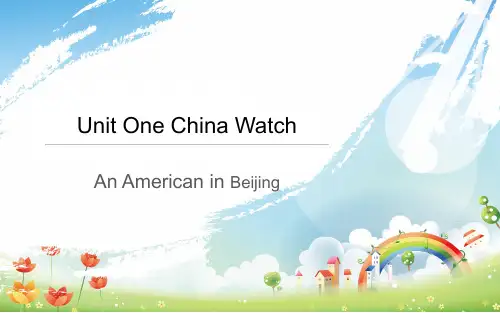

美英报刊阅读教程ppt课件目录CONTENCT •报刊阅读概述•美英报刊阅读技巧•美英报刊常见题材与写作风格•美英报刊词汇与语法特点•美英报刊文化背景知识•美英报刊阅读实践01报刊阅读概述报刊的重要性信息传递报刊是传递信息的重要途径,包括新闻、时事、社会动态等。
文化传承报刊作为文化载体,能够传承和弘扬社会文化。
思想交流报刊为人们提供思想交流的平台,促进不同观点和思想的碰撞与融合。
报刊的种类和特点种类包括日报、周报、月报等,涵盖政治、经济、文化、娱乐等各个领域。
特点具有时效性、真实性、客观性等特点,同时不同种类的报刊还具有各自独特的特点,如深度报道、评论分析等。
01020304提高语言能力了解国际动态拓展知识面培养批判性思维报刊阅读的目的和意义英文报刊涵盖各个领域的知识和信息,有助于拓展知识面和视野。
英文报刊是获取国际新闻和时事动态的重要途径,有助于了解全球发展趋势和热点事件。
通过阅读英文报刊,可以提高英语语言能力,包括词汇、语法、阅读理解能力等。
英文报刊中的评论和分析有助于培养批判性思维和独立思考能力。
02美英报刊阅读技巧80%80%100%阅读前的准备明确自己希望通过阅读获得哪方面的信息或知识,以便有针对性地选择阅读材料。
对于所选主题或话题,提前了解相关背景信息,有助于更好地理解文章内容。
根据标题、副标题、图片等线索,预测文章可能涉及的内容,为阅读做好准备。
确定阅读目的了解背景知识预测文章内容略读(Skimming)快速浏览全文,抓住文章大意和中心思想,确定文章是否符合阅读目的。
扫读(Scanning)寻找特定信息或关键词,如人名、地名、数据等,以便快速定位到所需内容。
精读(Intensive Reading)仔细阅读文章重要部分,理解作者观点、论据和细节信息。
批判性思维对文章内容进行批判性分析,评估作者观点的合理性和可信度,形成自己的见解。
回顾文章内容总结阅读收获分享与交流反思与改进简要回顾文章的主要观点和论据,加深对文章内容的理解。
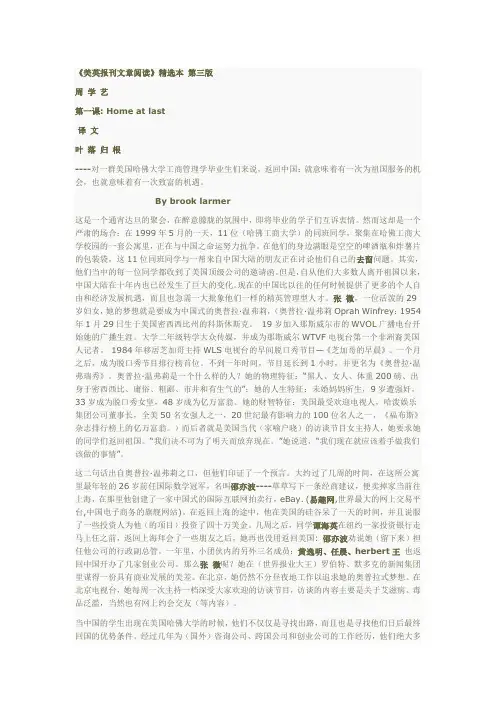
《美英报刊文章阅读》精选本第三版周学艺第一课: Home at last译文叶落归根----对一群美国哈佛大学工商管理学毕业生们来说,返回中国:就意味着有一次为祖国服务的机会,也就意味着有一次致富的机遇。
By brook larmer这是一个通宵达旦的聚会,在醉意朦胧的氛围中,即将毕业的学子们互诉衷情。
然而这却是一个严肃的场合:在1999年5月的一天,11位(哈佛工商大学)的同班同学,聚集在哈佛工商大学校园的一套公寓里,正在与中国之命运努力抗争。
在他们的身边满眼是空空的啤酒瓶和炸薯片的包装袋,这11位同班同学与一帮来自中国大陆的朋友正在讨论他们自己的去留问题。
其实,他们当中的每一位同学都收到了美国顶级公司的邀请函。
但是,自从他们大多数人离开祖国以来,中国大陆在十年内也已经发生了巨大的变化。
现在的中国比以往的任何时候提供了更多的个人自由和经济发展机遇,而且也急需一大批象他们一样的精英管理型人才。
张微,一位活泼的29岁妇女,她的梦想就是要成为中国式的奥普拉·温弗莉,(奥普拉·温弗莉Oprah Winfrey:1954年1月29日生于美国密西西比州的科斯休斯克。
19岁加入那斯威尔市的WVOL广播电台开始她的广播生涯。
大学二年级转学大众传媒,并成为那斯威尔WTVF电视台第一个非洲裔美国人记者。
1984年移居芝加哥主持WLS电视台的早间脱口秀节目—《芝加哥的早晨》。
一个月之后,成为脱口秀节目排行榜首位。
不到一年时间,节目延长到1小时,并更名为《奥普拉·温弗瑞秀》。
奥普拉·温弗莉是一个什么样的人?她的物理特征:“黑人、女人、体重200磅、出身于密西西比、庸俗、粗鄙、市井和有生气的”;她的人生特征:未婚妈妈所生,9岁遭强奸,33岁成为脱口秀女皇,48岁成为亿万富翁。
她的财智特征:美国最受欢迎电视人,哈泼娱乐集团公司董事长,全美50名女强人之一,20世纪最有影响力的100位名人之一,《福布斯》杂志排行榜上的亿万富翁。

![2024版美英报刊阅读ppt课件[1]](https://uimg.taocdn.com/25b823cc82d049649b6648d7c1c708a1284a0aa2.webp)
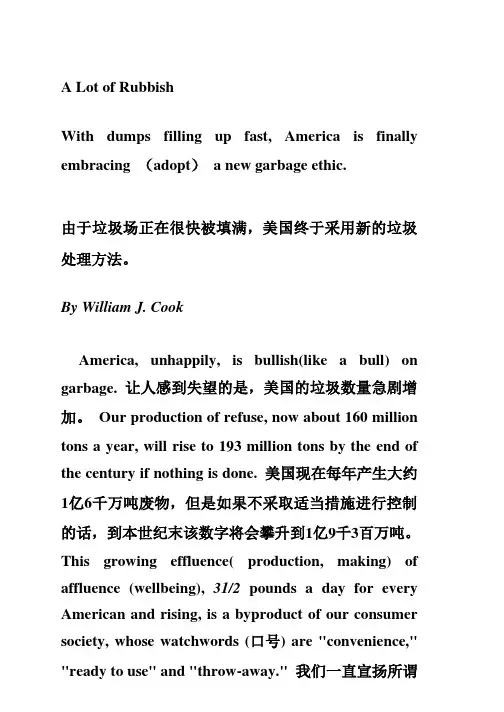
A Lot of RubbishWith dumps filling up fast, America is finally embracing (adopt)a new garbage ethic.由于垃圾场正在很快被填满,美国终于采用新的垃圾处理方法。
By William J. CookAmerica, unhappily, is bullish(like a bull) on garbage. 让人感到失望的是,美国的垃圾数量急剧增加。
Our production of refuse, now about 160 million tons a year, will rise to 193 million tons by the end of the century if nothing is done. 美国现在每年产生大约1亿6千万吨废物,但是如果不采取适当措施进行控制的话,到本世纪末该数字将会攀升到1亿9千3百万吨。
This growing effluence( production, making) of affluence (wellbeing), 31/2 pounds a day for every American and rising, is a byproduct of our consumer society, whose watchwords (口号) are "convenience,""ready to use" and "throw-away." 我们一直宣扬所谓的“便捷”“方便”和“一次性”,现在平均每个美国人每天产生3.5 磅并且该数字一直还在增加,富足的生活产生的垃圾,是我们这个消费社会的副产品。
And it has become a major national environmental issue, forcing citizens, elected officials and private companies to give serious thought to rubbish. 已经成为一个举国关注的焦点问题,迫使市民,政府官员以及私营公司齐心应对垃圾处理问题。
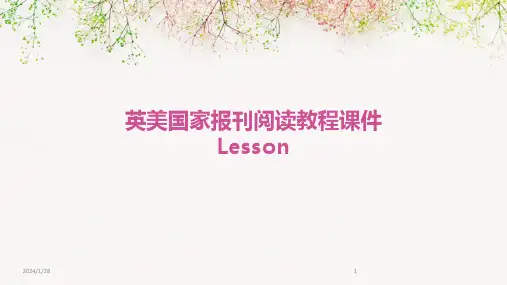
Lesson one Home at last1. Not only had China changed dramatically since most of them had left but also the nation could offer more personal freedoms and economic opportunities than ever before.2. Most of them like to go in for ecommerce.3. Because IT is the leading industry now.4. They want to gain experience in the States before they come back.5. It is the complicated relationship and the uncertainty of our human resource management system.6. It means some of the HBS elite have made their final decision to return to China to serve their country.Lesson two1.Osaka: nearly complet exclusion of non-JP companies from the project , built at the zenith of JP’seconomic powerGuangzhou: nearly completely designed and engineered by foreign companies, developing country with low-wage work force.2.Openness combined with China’s vast population of 1.3 billion. Potential size of its market.3.Its immense and low-paid work force.4.第一小问:Not necessary.第二:Yes, it is especially susceptible to economic booms and busts. At the same time, China’s one-party system may struggle to adapt to the social tensions brought to the surface by rapid economicdevelopment.第三:No, China’s strengths and using the experience of JP for reference.5.Fast development +vast population of 1.3 billion+ military muscle +increasing trade surplus.第二问:Trade with China. Cheaper labor=Cheaper products=preference of made-in-China=fewer sale of made-in US=fewer products of US factories=fewer job forUS.第三问;No, China’s strengths,especially the cheap labor advantage are partially the reason of theunemployment in US. The fast development cannot being undertaking without drawing any attention or attack.6.Susceptible to economic booms and bustsEconomic bubbleUnemployed adultsAcute setbacksLesson Three China finds western ways bring news woes1. The writer thinks that the best way to appreciate how much changed in China has is to examine the people themselves: what they eat and drink now and how dangerously overweight more than one-fifth of adults are.2. Traditional Chinese lifestyle emphasizes restraint while the Western lifestyle emphasizes indulgence. The change from Traditional lifestyle to Western indulgence will affect public health strongly: deaths fromdiet-related illnesses are expected to increase 10 times faster than population growth. And the increase in health care costs could slow down the economic development.3. Less exercise and more fat in the diet. Because people have more money than before.4. YES. He believes that increased supplies of alcohol, together with the rising disposable income, have stimulated drinking.5. YES. Unhealthy eating and drinking may cause diseases like heart attack, stroke and adult-onset diabetes, and the government will have to spend more money to treat these diseases.Lesson four 保护名胜古迹刻不容缓1.What activities are harming ancient Buddhist grottoes?Too many tourists and their breathing are harming them.2.Who turned the caves into the painted shrines?It was the travelers along the old silk road.3.Are murals in good shape.No, they are not in good shape. Many of them are already sagging or peeling from walls, and their delicate beauty is fading away. Others have deteriorated beyond repair efforts.4.Why is it difficult for the authorities to prevent them from being destroyed?Money is at the root of the problem. China is a poor nation. Local governments have little money left over for cultural conservation.5.Does the Chinese government value the preservation of those historical and cultural sites?Yes, it does. For instance, it has given award to the Getty Conservation Institute for its contributions to the preservation of them at Dunhuang.6.Why did Mr. Neville Agn ew say “ tourism and conservation are good partners”?If you can make a good connection, they are. In other words, if you can allocate part of the money earned from tourism to conservation, and don’t turn to tourism as a cash cow, they will be good partners.Lesson five The evolution wars1. in the late fall. This is a challenge to Darwin’s theory which is widely regarded as one of the best-supported ideas in science since it comes from decades of study and objective evidence. Till now Darwin’s theory is the only explanation for the rich variety of life forms on Earth, so scientists fell horrible.2. Bush supports the idea of introducing both evolutionism and intelligent design in biology class. His attitude will further provoke battles on the topic and even bring more political and competitive pressure on science.3. NO. Because Darwin’s theory has conflicted with people’s religious convictions. The “monkey trial” was a famous case, in which Tennessee school teacher was convicted of violating the ban of teaching evolution in 1925. That was a big war between creationism and evolutionism.4. Living things are too exquisitely complex to have evolved by a combination of chance mutations and natural selection. Some pieces in the fossil record that may prove the evolution process are missing.5. NO. The earlier anti-Darwinists, mostly creationists, regarded evolution as a heresy and they openly claimed the role of God. But the proponents of intelligent design accept some role of evolution and they avoid bringing God into the discussion.6. They think the intelligent design is faith-based, so the debate about evolution is not a real scientific argument.7. Because it is difficult for people to argue over such benign and earnest language. This can even make people feel the theory a scientific one and avoid violation against the Constitution.8. 开放性问题。